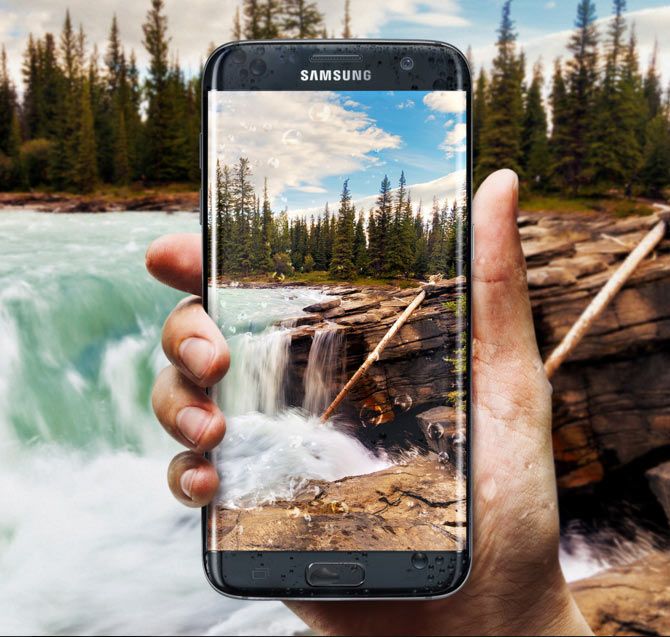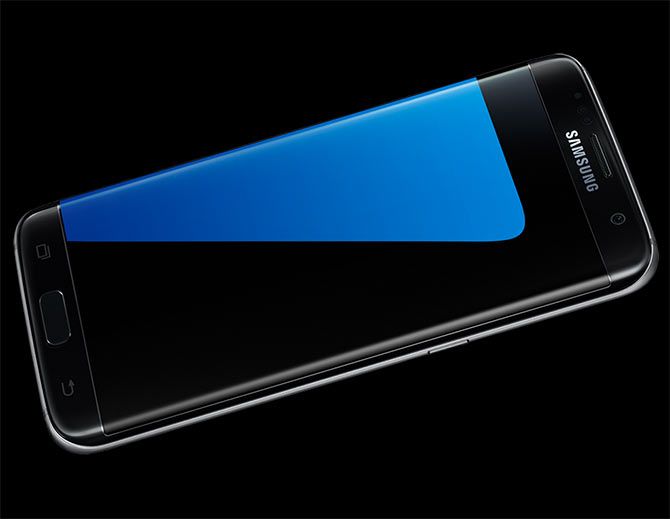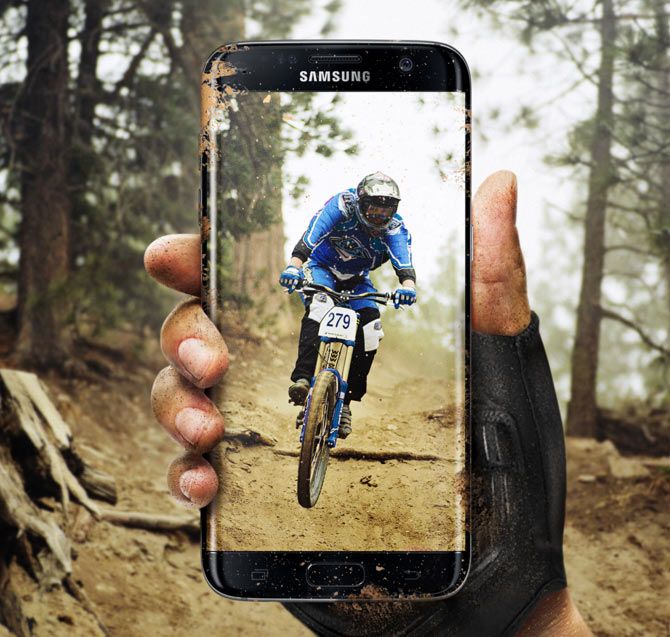Himanshu Juneja takes a close look to ascertain if the premium it asks for is justified.
Also Read: Samsung Galaxy S7 is a class apart!

That Samsung had to reinvent itself after receiving criticism from all corners is last year's news. That they did it successfully and again got the bragging rights with the Galaxy S6 series is well known as well. The real challenge for Samsung and its team was, where do they go next? How do they re-invent the wheel?
This year, Samsung went ahead and cleaned up last year's model, making it sleeker, leaner and touched upon the shortcomings. They brought back the microSD card slot, ditto with water resistance certification, and got a battery to match the powerful innards.
One would think that the Galaxy S7 Edge would require rocket fuel instead of the usual battery power. Seriously though, the handset comes with drop dead gorgeous looks, a shimmering display unit, class leading camera, and a hefty price tag.
Construction

Remember the class topper who would try to be modest while there was a very prominent aura around him/her? That is precisely the feeling that hits while holding the Samsung Galaxy S7 Edge. The handset is probably the most striking piece of hardware till date, oozing premium feeling all around. The metal and glass construction maybe a given these days, only a few would get things this spot on.
The handset comes with Corning Gorilla glass 4 protection on the front and the back, while the rounded off corners gives a further smooth, accentuated look and feel. Measuring 150.9 x 72.6 x 7.7 mm in dimensions, the sleekness and the incredibly light weight of 157 gms delights the observer while holding the phone.
The fingerprint scanner embedded in the homekey sits right at the front, flanked by the standard buttons on the sides.
Turn the phone around, and the camera bump being absent is a pleasant surprise. The heart rate monitor sits just besides the camera, and the curved back assists in getting a comfy grip. The only complain would be the smudges which the glass keeps attracting.
Samsung got the IP68 certification back, which makes the phone dust and water resistant, and there are no extra flaps thrown around to achieve this. The hybrid SIM/Memory card slot rests right at the top, while the left edge is carrying the volume buttons. The right edge has the power/lock key and the bottom edge has the microUSB charging port, the 3.5 mm audio jack, and the speaker grille.
Display
The Galaxy S7 comes with what one expects Samsung to dole out. The 5.5-inch screen comes with Super AMOLED technology, and the 2560 x 1440p display cranks up the pixel density count right up at 534ppi.
The QuadHD display brings the goodness of the AMOLED screen type, giving the gorgeous and deep black levels. The colours are punchy, but not to amateurish levels. The resulting images are vivid and packed with details. Gorilla Glass 4 only reinforces confidence.
The screen is perfectly usable under direct sunlight owing to sufficient brightness levels, but the screen is pretty reflective as well. The edge display depicts a strong bluish hue when looked at an angle. Nothing to be overtly bothered about.
Samsung decided to bring the Always-On display, allowing users to catch a glimpse of important information like time, date and notifications. Unfortunately, it is still nascent. The notifications are limited, and there is no control over brightness levels. Thankfully, it can be turned off, if it bothers the users a lot.
Specifications
The S7 Edge packs Samsung's proprietary Exynos 8890 SoC, and is basically chugging on a set of Quadcore processor (clocked at 2.3GHz), while the other set of Quadcore processor (Cortex A 53) is clocked at 1.6 GHz.
There is ample amount of RAM in the form of 4 GB, while Mali T880 takes care of the graphics department. 32 GB of onboard storage space looks good, while the users can further expand this by another 200 GB, courtesy the hybrid slot.
Connectivity
Samsung has ensured that their marquee flagship device comes choc-a-bloc with connectivity options. The dual SIM device is 4G LTE enabled, while also carrying features like WiFi (802.11 b/g/n/ac), Bluetooth (ver 4.2), GPS with A-GPS and GLONASS.
NFC also makes the cut, while IR emitter and radio have been dropped. Some maybe relieved with Samsung opting out of the USB Type C bandwagon, as it has still not gone mainstream.
Operating system
The Galaxy S7 Edge comes with Samsung's Touchwiz skin, while keeping Android Marshmallow (ver 6.0) as the underlying OS. Touchwiz has become more leaner and faster; it still is worth about 7 GB in size, which is a decent heft.
Naturally, there is bloatware around, but Samsung has kept things quite manageable. The theming engine is there to keep users busy with customisations, while apps like S Planner and S Health are made relevant by the features and utilities they provide.
There is the Microsoft's suite, complete with Office and Skype Apps. Unfortunately, these can be only disabled. Samsung went a bit snobbish, as it does not allow its own browser to be even disabled! Nothing of a deal breaker thankfully.
There is this feature rich folder by the name of Game launcher, allowing users to stream their gaming experience, capturing screenshots, and providing other options while being inside the game. Disabled notifications should help avid gamers with seamless experience.
The amount of toggles supplied over the notification area always has been a blessing. The split screen feature for multitasking found its home on Samsung quite earlier, and here too it remains quite a natural choice owing to large display screen. There is support for gestures like flip to mute, quick launch of camera, capturing screenshots etc, all these bring a good value to the user experience.
Quirkily, Samsung has removed Flipboard, but opted for Upday. Keeping the logic for choosing the name aside, it still raises eyebrows as it does pretty much what Flipboard did -- aggregating news from curated sources. Samsung has taken out the adoptable storage option from Marshmallow. Users can still move their apps to the microSD card, but it is still not the way Android intended it to be. This should be fixed by Samsung, no two ways about it.
Overall speaking, the experience is smooth and delightful, but it has its bumps along the way as well. Samsung still has something to tweak, adjust and improve with their next flagship it seems.
Performance
There was no issue found with the device while taking it through the hoops. The HD content ran with sheer aplomb, with the games showing up in their full glory, and the browser with multiple tabs did not pose a hindrance either.
That being said, Samsung ought to take note that there were instances of slight lags like while bringing up he multitasking screen up. Occasionally, an app would take a fraction more time than expected to launch. The S7 Edge is a powerhouse by all counts, and the lag should not have been there at all.
To keep the fiery processor under check, Samsung got the water cooling technology onboard, and as the temperatures never raised any alarms, seems like dividends been paid.
The finger print scanner is worthy of praise as well. The user needs to press the Home key and then keep the finger on for a split second. The scanner recognises a finger in a flash and unlocks the device. The speaker was perfectly loud, but lacked the fidelity of something like HTC BoomSound speaker. But we are nit picking.
Camera

This here is the undoubtedly one of the strongest feature of the S7 Edge, capable enough to notch up the sales figure by itself. Samsung has supplied the phone with a 12 MP dual-pixel rear camera, complete with Optical Image stabilisation and LED Flash. The front facing shooter is a 5 MP affair, and both the cameras come with an aperture of f/1.7, which is very impressive to say the least.
The rear camera's pixel count may be low according to some, but that count is never the complete story. Add to it the fact that Samsung is using dual pixels, the 1.4µm pixels are already compensating, thanks to the bigger size.
The camera attains focus in a super quick fashion. Panning around does not seem to be a task for the processor or the software, as focus and face tracking speed remains on the money. A double tap on the home key launches the camera app instantly.
The pics came out packed with details, and colours are vivid and natural. Even the details from shaded areas get picked up, and one hardly will feel the need to go into the HDR mode. Speaking of it, the HDR mode does a fantastic job when summoned. Live HDR mode makes life more easier with the previews.
The night time photography is worth its weight in gold. Even with slightest of the light source around in a dimly lit room, the details are picked nicely, while keeping the noise to bare minimum. One can easily identify people, objects, thanks to the dual pixels and the impressively bigger aperture count. OIS being present is a massive advantage.
Selfies come out great too. The aperture again plays a role, but screen can be used to lighten up the faces literally. Wide angled lens only helps the cause.
The app is pretty rich as well, providing plenty of shooting modes and tweaks even for prosumers. Panorama mode especially is easy on the eyes, while lacking a bit of details. Stitching was very impressive. Pro Mode allows for granular control over ISO, shutter speed, white balance, etc. Live broadcast and Motion photo are a nice touch, with the latter allowing user to capture a 3 second video with the captured picture. Users can of course grab modes via store as well.
Speaking of videos, the rear camera can do 4k, 1440p, 1080p, slow motion 720p and hyperlapse videos as well. The quality again was stunning, with colours being again on the mark, and optical image stabilisation contributing nicely. Sharpness was not an issue either, and in fact, the screenshots from videos are capable enough to be passed around as standalone pics.
Battery
The S7 Edge has been entrusted with a 3600 mAh battery, which is non-removable. On regular or even heavy usage pattern, one can easily get over a day's worth of usage here, with about 20 per cent battery level still showing up. Should the need arise, the power saving modes are included as well.
Regular power saving mode begets another hour or so, while the ultra power saving mode makes the phone go into an absolutely vanilla operation mode. The fast charging feature ensures that the handset is fully charged within 90 mins flat. There is also the wireless charging compatibility. Particularly handy should be the Adaptive charging, 10 minutes of which allows the phone to carry on for about 4 hours.
Verdict

Call it competition, or natural progression, Samsung definitely brought their game here. Despite the large screen, using the Galaxy S7 Edge is not an issue at all. The brilliantly crafted device with its class leading features makes it the undisputed front runner in the world of mobile phone. The camera alone will make even the owners of the previous flagship phone sit up and notice.
Unfortunately, priced at a steep Rs 56,999, the phone is not an automatic recommendation. Those with budget constraints will mostly veer more towards the Galaxy S7, which is priced at Rs 48,900 and comes with the same camera module.
If the budget and using a curved display is not an issue, the Samsung Galaxy S7 Edge is a sure shot purchase, with only the upcoming HTC 10 being a worthy contender in the foreseeable future.











 © 2025
© 2025